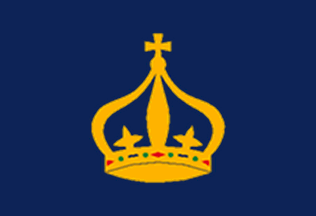 image by Dirk Schönberger,
10 November 2012
image by Dirk Schönberger,
10 November 2012Source: http://pt.wikipedia.org/wiki/Ilhabela

Last modified: 2012-12-15 by ian macdonald
Keywords: sao paulo | ilhabela |
Links: FOTW homepage |
search |
disclaimer and copyright |
write us |
mirrors
 image by Dirk Schönberger,
10 November 2012
image by Dirk Schönberger,
10 November 2012
Source:
http://pt.wikipedia.org/wiki/Ilhabela
A dark blue flag with a large crown centred.
Official website at
http://www.ilhabela.sp.gov.br
Dirk Schönberger,
10 November 2012
Ilhabela was discovered on 20 January 1502 by the three caravels forming the Portuguese expedition commanded by Gonçalho Coelho. Since the 20th of January is St. Sebastian's Day, the colonizers renamed the Maembipe island for the saint. Amerigo Vespucci, member of the expedition, wrote much later that paradise on earth, were it to exist, would probably be located in the neighbourhood. For various reasons, the region remained uninhabited for the next century after its discovery. The first Portuguese colonists, Diogo de Unhate and João de Abreu, settled the place in 1608 only; the main industry developed on the island was slavery-manned sugarcane cultivation and sugar production. On 16 March 1636; the "vila" of Ilha de São Sebastião - subsequently renamed São Sebastião da Terra Firme and, eventually, São Sebastião - seceded from Santos. The main landlord of the time, Francisco de Escobar Ortiz, mostly traded slaves from Angola on the ship of his private fleet; he also built the first two sugar mills on the island and attempted to colonize the Vitória do Espírito Santo island, to no avail. The whole São Sebastião island was eventually incorporated in the territory of the town of the same name in the early 19th century.
The northern shore of today's São Paulo State was scoured by European and local pirates and privateers, including the four most famous of them, Cavendish, Drake, Knivet and Duguay-Trouin. To protect the towns of Bela da Princesa and São Sebastião, the Portuguese built a network of seven forts on the two sides of the Toque-Toque Channel, the biggest of them, the Rabo Azedo fort, being located in the north of the São Sebastião island. In 1785, a chapel dedicated to Nossa Senhora dŽAjuda e Bom Sucesso was established. At the end of the 18th century, some 3,000 inhabitants lived on the island, experiencing harsh times due to the bust of sugar industry. On 3 September 1805, upon the pressure of 27 prominent inhabitants of the island, the Vila Bela da Sereníssima Princesa Nossa Senhora was established. The town was named for Maria Teresa Francisca de Assis Antonia Carlota Joana Josefa Xavier de Paula Micaela Rafaela Isabel Gonzaga de Bragança, Princess of Beira, the senior daughter of King of Portugal John VI. The town would benefit for the next 80 years of the boom of coffee, grown on some 30 estates on the São Sebastião and Búzios islands; the population quickly increased to 10,000. Following the bust of coffee and the abolishment of slavery (1888), Ilhabela declined for the next 70 years. In the first quarter of 20th century, the island specialized in the production of cachaça liquor, with 13 distilleries. In 1934, the municipality of Vila Bela da Princesa was suppressed and transformed into a district part of the municipality of São Sebastião. Six months later, the municipality was reestablished upon pressure by the inhabitants. On 1 January 1939, the municipality was renamed Vilabela. On 4 May 1940, the name was changed again, to Formosa. Yet another people's uprising caused the adoption of a new name, the municipality of Ilhabela being established on 1 January 1945.
In the 1970s, the cachaça distilleries closed but tourist industry emerged, causing anarchic urbanization of the island until the 1990s. In 1997, the municipal government issued strict urbanist rules aimed at preserving the environment. Most (78%; 27,025 ha) of the municipal territory of Ilhabela forms the Ilhabela State Park, established on 20 January 1977 by State Decree No. 9,414. Ilhabela was awarded the title of "National Capital of Sailing" on 26 July 2011 by Law no. 12,457. The Ilhabela Sailing International Week is a main South American sports event organized since 1973, involving 1,500 sailors and 400 boats - and watched by some 50,000 visitors.
The flag of Ilhabela is blue with a yellow crown. The flag is derived from the municipal coat of arms, "Azure a crown or above a cannon argent, a bordure of the same".
Photo of the flag
http://hoteliernews.com.br/2011/02/SPCVBfirmaacordodecooperaocomprefeituradeIlhabela - 2 February 2011
Ivan Sache, 11 November 2012